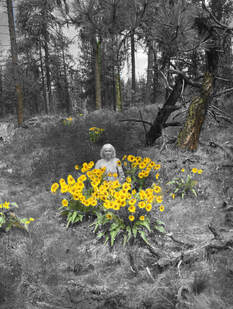Dr. Greg's Historical & Modern Photography
Just for Fun

The title "Just for Fun" means exactly what it says. I like to play with images when I have some spare time. Most of my photography is for the serious purpose of saying something I believe needs to be said. "Just for Fun" allows me to experiment with images and not have a particular purpose in mind. This particular image was shot on my ipad mini and manipulated in PhotoShop. The wonderful yellow flowers are arrowleaf balsam root. They bloom only in April and May here, and then for a really short time (maybe a week or two) before they lose the flowers and are just another green plant. Here's a little information about its historical use:
Native Americans relied on all parts of arrow-leaf balsamroot for food. Young leaves and shoots were peeled and eaten raw, boiled or steamed. The peeled roots have a bitter, strongly pine-scented sap. When cooked for several days (roasted or steamed) the root became edible and was often ground into meal and mixed with grease and made into cakes, or mixed with powdered berries and eaten with a spoon. The small, sunflower-like seeds were dried or roasted and pounded. The plant was also used for medicinal purposes, with the leaves being used as a poultice for burns, the roots boiled and the solution applied as a salve for wounds, cuts and bruises, and a tea derived from the roots used as a treatment for tuberculosis and whooping cough. Today, it is added to muffins, breads and granola, and can also serve as an emergency survival food. Modern herbal practitioners may use the root as an immunostimulant or expectorant.
Native Americans relied on all parts of arrow-leaf balsamroot for food. Young leaves and shoots were peeled and eaten raw, boiled or steamed. The peeled roots have a bitter, strongly pine-scented sap. When cooked for several days (roasted or steamed) the root became edible and was often ground into meal and mixed with grease and made into cakes, or mixed with powdered berries and eaten with a spoon. The small, sunflower-like seeds were dried or roasted and pounded. The plant was also used for medicinal purposes, with the leaves being used as a poultice for burns, the roots boiled and the solution applied as a salve for wounds, cuts and bruises, and a tea derived from the roots used as a treatment for tuberculosis and whooping cough. Today, it is added to muffins, breads and granola, and can also serve as an emergency survival food. Modern herbal practitioners may use the root as an immunostimulant or expectorant.